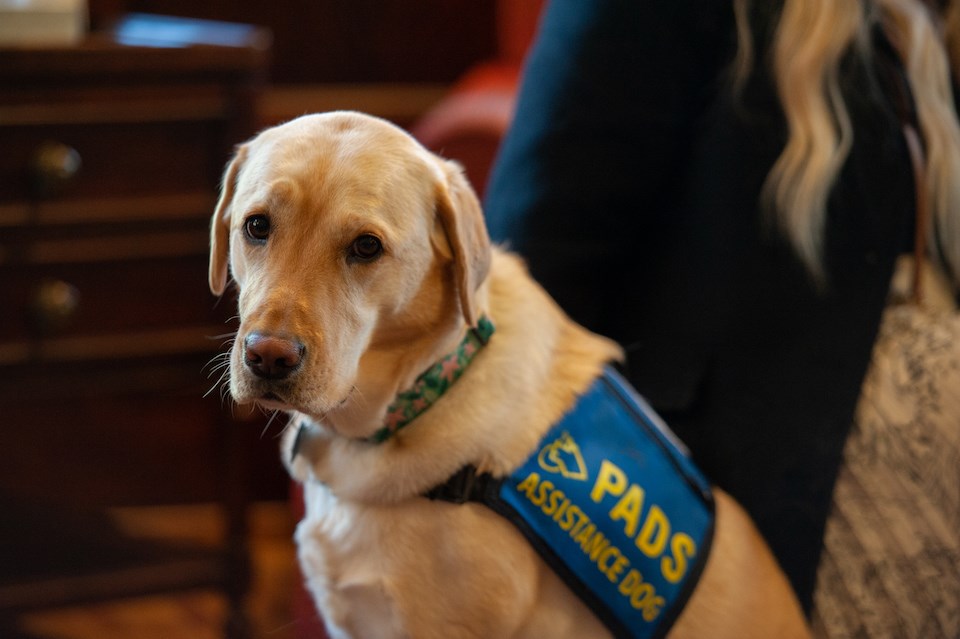Gaia is a profoundly special dog — but you don't really understand how until she touches you.
I visited the Canuck Place Hospice on April 22 to meet the golden, kind-eyed member of the team and her handler Camara van Breemen.
Most people consider their four-legged furry best pals to be unique, loving members of their family, but Accredited Facility Dogs have an important and difficult job.
Gaia provides comfort and emotional support to children who are living with life-threatening illnesses. She was selected among dozens of candidates to work at Canuck Place, which gives inpatient and community care to over 800 children and families from five provincial health regions.
Accredited Facility Dogs differ from therapy dogs as they are bred and trained to do this work full time. And, as Pacific Assistance Dogs Society (PADS) Executive Director Laura Watamanuk told Vancouver Is Awesome, not all dogs are equipped for the job. In fact, dogs like Gaia are rare.
"Finding a dog that not only has the aptitude to do it but also has the resilience to do it day in and day out as kind of a full-time gig... it's sort of like the people who do this work," she explained.
"It's a special breed of people that can work in an environment like this."
The program launched 15 years ago with a dog named Poppy, a beloved golden retriever who retired about four years ago. Then, with support from partners Pacific PADS and YVR for Kids, Canuck Place welcomed new team member Gaia in February 2021.
PADS has 120 working teams across Western Canada and breed, raise and train fully certified assistance dogs. The service (mobility & PTSD) and hearing dogs provide life-changing independence to those with physical disabilities other than blindness. The accredited facility dogs work with community professionals, such as teachers, RCMP and psychologists to help support healthy communities.
The difference between an Accredited Facility Dog and a therapy dog is that they are bred and trained to do important work full time. Most dogs would be worn out after working in this type of setting, but Gaia has the particular emotional stability needed for the job. Additionally, many dogs provide therapeutic comfort but haven't been trained professionally.
But it isn't only her resilience that makes the lab ideal for this work.
Gaia is drawn to people who need her — and she has the uncanny ability to sense who does.
"She's an incredibly gentle soul."
When I was sitting in the room with van Breemen, Watamanuk, and V.I.A. photographer Ethan Cairns, Gaia stayed mostly by her handler's side as I recorded the interview. At one point, however, she moved directly across the room and gently placed her back beneath my arm. And when I say gently, I mean to say that it was as if she was placing herself beneath an egg — strikingly tender.
I was overcome with relief. I can't tell you what I was holding inside of me at that moment, but what I can tell you is that it melted away the moment she made contact. I was flooded with comfort.
"She's sitting beside you for some reason. We don't have to speculate," van Breemen remarked, adding that she typically will move around the room to different people.
"I put her up on beds in [intensive care units] with tubes going into very sick babies and these babies are saying goodbye to their families. And I get her up on the bed and she lies right down beside them and puts her head right where I ask her to.
"It's remarkable."
Watamanuk echoed that sentiment, adding that it is a big responsibility to trust a dog to be with a family that is going "through the worst day of their life." They must have absolute certainty the dog will have an intuitive gentleness.
"That's not a moment where you can afford a dog that will jump up and be silly," she explains.
"That's one thing we've always known about Gaia, that she's an incredibly gentle soul."




